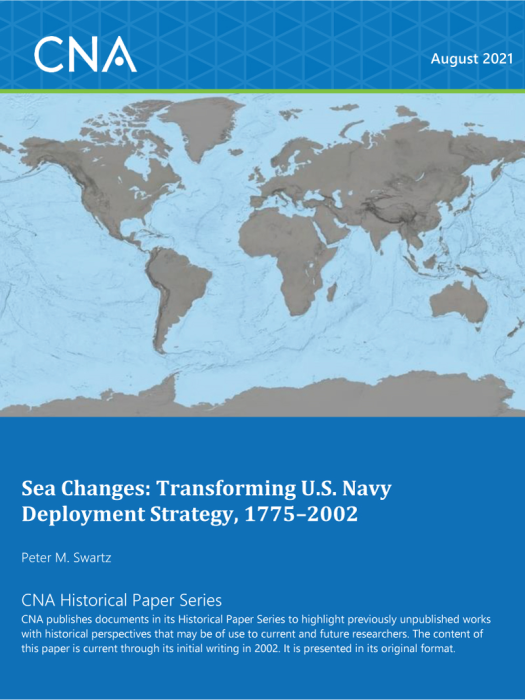Background
This paper examines the many changes in U.S. Navy strategic and operational history over time, focusing on the Navy's deployment strategy. From this examination, it draws insights, options, and conclusions for today's Navy, to provide useful context and perspective.
This study was written to help inform debate and discussion about the present and future Navy. We call it Sea Changes to highlight its principal finding and to emphasize its contemporary relevance. It is, however, also intended to remain of value to future decision-makers and planners once current U.S. Navy planning is itself part of history.
Major insights, options, and conclusions
- The roots of current U.S. Navy deployment strategy can be traced back to the late 1940s, when Secretary of the Navy James Forrestal, Admirals Forrest Sherman and Arthur Radford, and others deployed what became the Sixth Fleet to the Mediterranean and later a reborn Seventh Fleet in the western Pacific, as combat-credible forward presence forces. The efforts of Admiral Elmo Zumwalt and others at the beginning of the 1970s made the Seventh Fleet a forward-based as well as forward-deployed force. At the end of the 1970s, a third combat-credible forward presence "hub" was created in the Arabian Sea. Meanwhile, precedents of intermittent forward presence were established and maintained in many other forward sea areas, and continued in America's "near abroad" in the Caribbean.
- The combat-credible forward presence strategy has been the product of the domestic power and interests of the United States, the world environment within which the United States must live, and the human and technological capabilities of the U.S. Navy and other United States national security institutions.
- Prior to the late 1940s, the Navy followed many other deployment strategy models, including periodic surges from the United States for diplomacy or combat, permanent forward stations scattered around the world, round-theworld cruising, and maintaining fleet combat readiness at home while positioning a few forward stations abroad.
CNA Historical Paper Series
CNA publishes documents in its Historical Paper Series to highlight previously unpublished works with historical perspectives that may be of use to current and future researchers. The content of this paper is current through its initial writing in 2002. It is presented in its original format.
DISTRIBUTION STATEMENT A. Approved for public release: distribution unlimited.
Details
- Pages: 244
- Document Number: DIM-2019-U-022208-1Rev
- Publication Date: 8/6/2021
